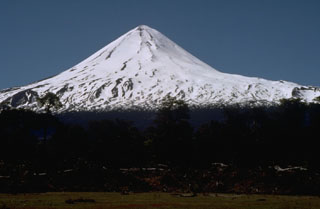Report on Llaima (Chile) — March 1990
Bulletin of the Global Volcanism Network, vol. 15, no. 3 (March 1990)
Managing Editor: Lindsay McClelland.
Llaima (Chile) Small explosion ejects incandescent column; strong seismicity
Please cite this report as:
Global Volcanism Program, 1990. Report on Llaima (Chile) (McClelland, L., ed.). Bulletin of the Global Volcanism Network, 15:3. Smithsonian Institution. https://doi.org/10.5479/si.GVP.BGVN199003-357110
Llaima
Chile
38.692°S, 71.729°W; summit elev. 3125 m
All times are local (unless otherwise noted)
A small explosion on 25 February, followed by the ejection of a glowing column from the main crater, was reported by Conguillio National Park administrator Omar Toledo. He added that small sediment-laden streams of water had flowed down the E flank at times when thawing does not normally occur. Field observations by geologists 5-18 March revealed occasional increases in fumarolic activity from the main crater. On 10 March, vigorous 40-60-second puffs of gas were emitted every minute during the early evening. After a summit climb, Conguillio National Park rangers reported that intense fumarolic activity produced grayish gases and a strong sulfur odor. Rockslides occurred every 1-2 hours on the NE flank.
A portable seismograph was operated 19-22 March at the volcano's W foot (in Los Paraguas National Park) by Jaime Campos and Bertrad Delovis, Dept de Geofísica, Univ de Chile. Intense volcanic earthquakes and tremor were recorded. Another portable seismograph will be installed at the NE foot (near Conguillio Lake) by Univ de la Frontera scientists.
Geological Summary. Llaima, one of Chile's largest and most active volcanoes, contains two main historically active craters, one at the summit and the other, Pichillaima, to the SE. The massive, dominantly basaltic-to-andesitic, stratovolcano has a volume of 400 km3. A Holocene edifice built primarily of accumulated lava flows was constructed over an 8-km-wide caldera that formed about 13,200 years ago, following the eruption of the 24 km3 Curacautín Ignimbrite. More than 40 scoria cones dot the volcano's flanks. Following the end of an explosive stage about 7200 years ago, construction of the present edifice began, characterized by Strombolian, Hawaiian, and infrequent subplinian eruptions. Frequent moderate explosive eruptions with occasional lava flows have been recorded since the 17th century.
Information Contacts: H. Moreno, Univ de Chile; J. Naranjo, SERNAGEOMIN, Santiago.

